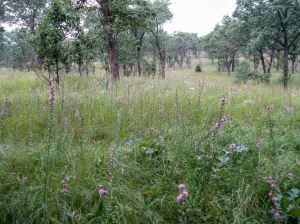by Carl Strang
As children, we can hear all the singing insects. As we age, though, we gradually lose our ability to hear the higher-pitched ones. When I began to study them in 2006, I already was unable to hear any of the small meadow katydids (genus Conocephalus) in the field. I acquired a device called the SongFinder, which lowers the pitch of songs by cutting their frequency to half, one-third, or one-fourth.

A few years ago, I learned that this device no longer is made, and sought a backup. I ended up with a bat detector.

This one, called the Walkabout, can be set to the range of the higher-pitched singing insects (most bat detectors are limited to frequencies above that range). It has the further advantages of having a speaker instead of headphones, a visual display of the sounds it picks up, and can make recordings. Furthermore, unlike the limited directionality of the SongFinder, its microphone cone attachment allows the user to zero in on a single singing insect for a visual identification.
This year I made better use of both devices, playing with settings and making recordings to improve my ability to find Conocephalus katydids and identify them by their songs, without having to see them. In the following review of species, you may well be able to hear the recordings (made with the Walkabout, with one exception), either because you are in a quiet setting without the competing sounds that overwhelm in the field, or because the recordings are somewhat pitch-reduced.
The most common of these critters in the Chicago region is the short-winged meadow katydid (C. brevipennis). These occur in grasses in a wide range of habitats.

Its song consists of usually 1-3 evenly spaced ticks followed by a short buzz:
The next most common species, which occurs in wet to mesic grasses, is the slender meadow katydid (C. fasciatus).

Here, the ticks are more irregularly spaced and usually more numerous, the whole impression much less metronomic than in the short-winged:
This year I became better acquainted with the black-sided meadow katydid (C. nigropleurum).

One of our more beautiful singing insects, the black-sided is limited to wet areas with some coarser herbaceous vegetation or woody stems. Its song is a continuous series of snare-drum-like rapid ticks (this recording I made with my Marantz digital recorder and a Sennheiser shotgun mike, and includes a common true katydid singing nearby):
The shape of these ticks is distinctive when viewed in a sonograph. This image is one second’s worth:

Another, less commonly encountered wetland species is the long-tailed meadow katydid (C. attenuatus), which can be all brown as in the photo, but also can have bright green legs.

It also has a continuous song that is more like a buzz, the pulses coming more rapidly:
The sonograph shows that the pulses are regular and identical, in this image 0.2 second’s worth:

The straight-lanced meadow katydid (C. strictus) lives in sparser grassy vegetation on poor, dry soils.

Its song resembles that of the long-tailed, but their habitats are distinct.
Also, the volume increases and decreases. This 0.2-second sample shows a decrease:

There are two other Conocephalus species in the region, the woodland meadow katydid (C. nemoralis) and the prairie meadow katydid (C. saltans). The former has a song consisting of rapid-fire brief buzzes, some of which are separated by drumrolls of ticks. The latter produces a continuous series of even briefer buzzes, so short they are almost tick-like. I need better recordings of both, and hope to get them next year.
























































